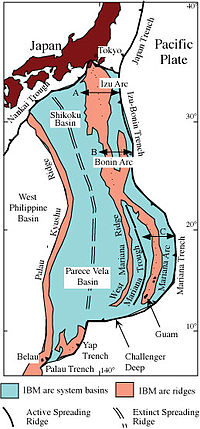
Photo from wikipedia
The alteration and dehydration of predominantly basaltic subducting oceanic crustal material are thought to be important controls on the mechanical and hydrological properties of the seismogenic plate interface below accretionary… Click to show full abstract
The alteration and dehydration of predominantly basaltic subducting oceanic crustal material are thought to be important controls on the mechanical and hydrological properties of the seismogenic plate interface below accretionary prisms. This study focuses on pillow basalts exposed in an ancient accretionary complex within the Shimanto Belt of southwest Japan and provides new quantitative data that provide insight into clay mineral reactions and the associated dehydration of underthrust basalts. Whole-rock and clay-fraction X-ray diffraction analyses indicate that the progressive conversion of saponite to chlorite proceeds under an almost constant bulk-rock mineral assemblage. These clay mineral reactions may persist to deep crustal levels (~320 °C), possibly contributing to the bulk dehydration of the basalt and supplying fluid to plate-boundary fault systems. This dehydration can also cause fluid pressurization at certain horizons within hydrous basalt sequences, eventually leading to fracturing and subsequent underplating of upper basement rock into the overriding accretionary prism. This dehydration-induced breakage of the basalt can explain variations in the thickness of accreted basalt fragments within accretionary prisms as well as the reported geochemical compositions of mineralized veins associated with exposed basalts in onland locations. This fracturing of intact basalt can also nucleate seismic rupturing that would subsequently propagate along seismogenic plate interfaces.Graphical abstractSchematic model showing the setting for décollement step-down into the ocean-plate basalts at the subdution plate interface. The diagram also shows textures of intact basalt and its expected frictional properties and behaviors associated with seismogenesis.
Journal Title: Earth, Planets and Space
Year Published: 2017
Link to full text (if available)
Share on Social Media: Sign Up to like & get
recommendations!